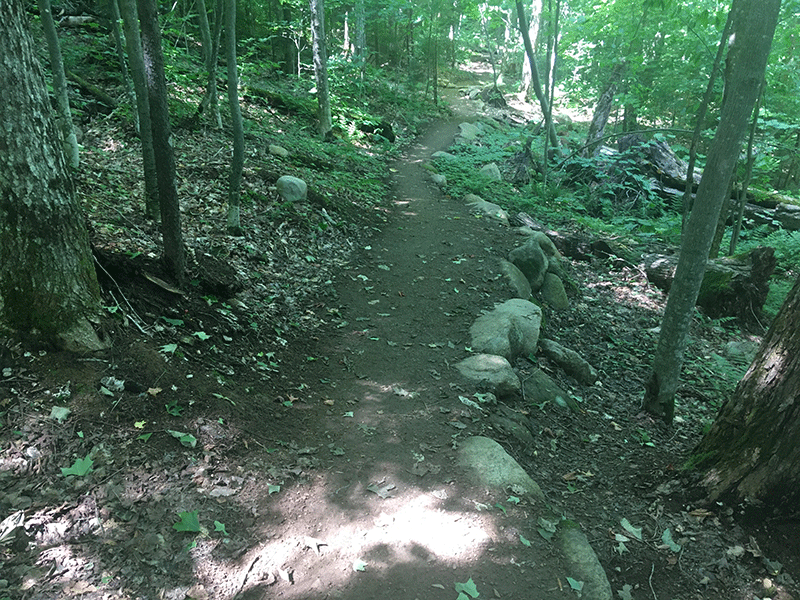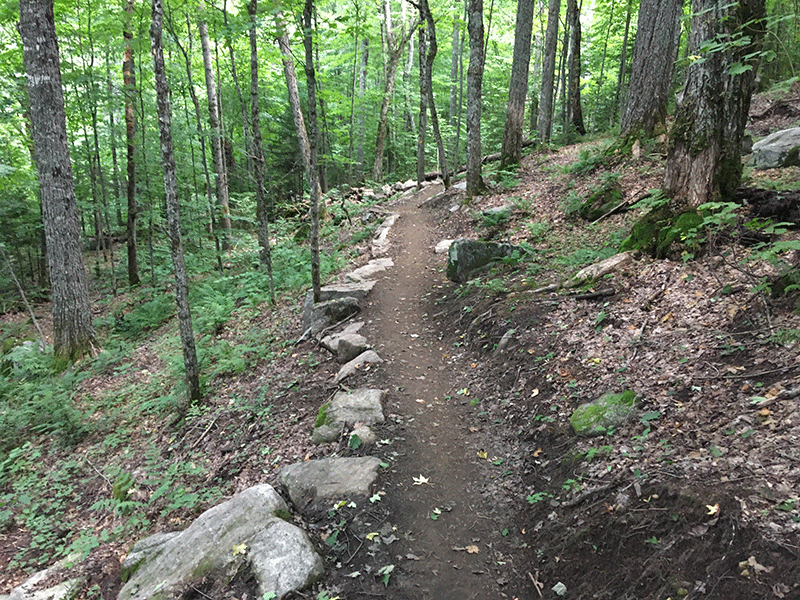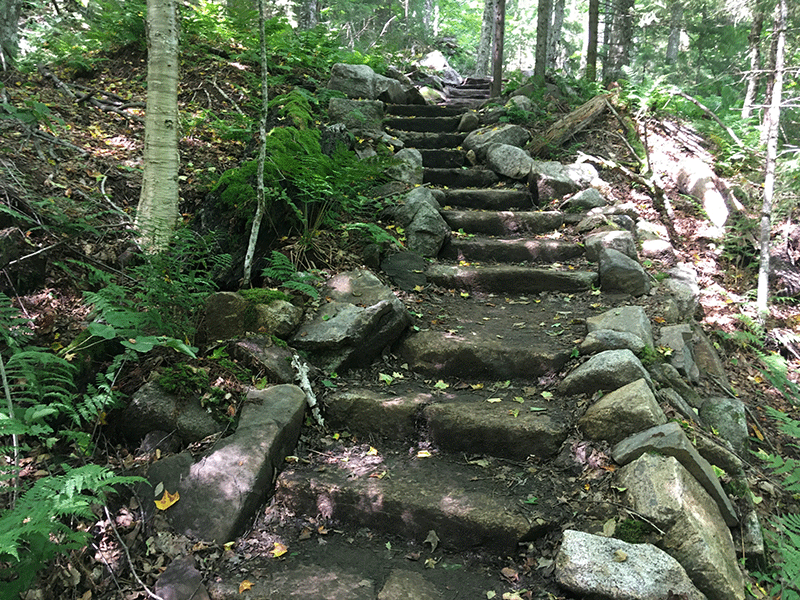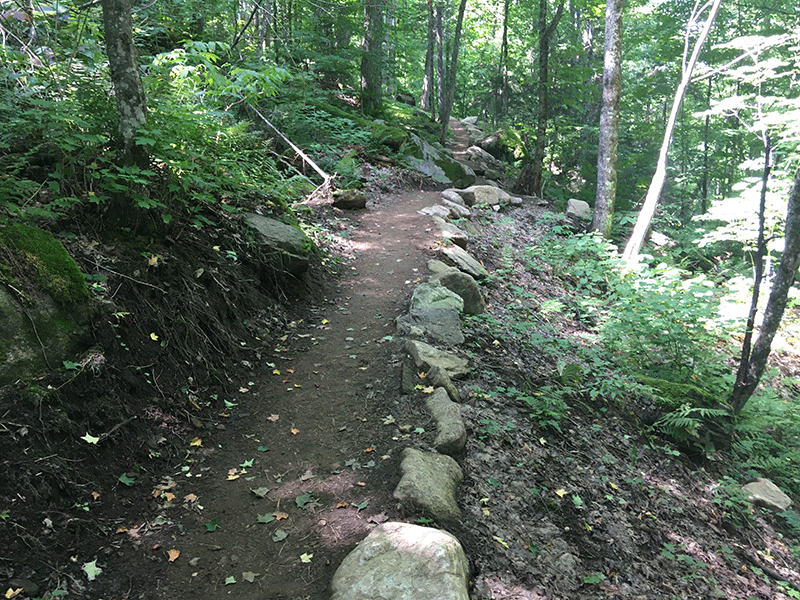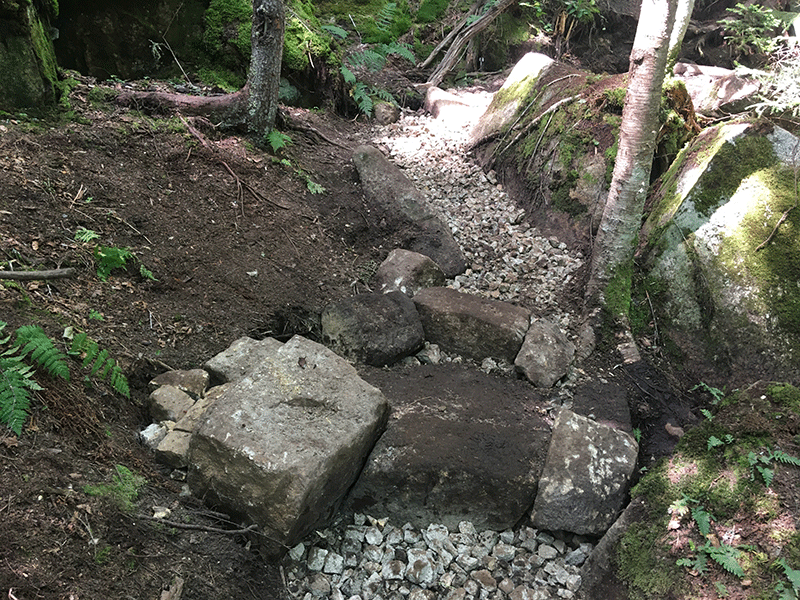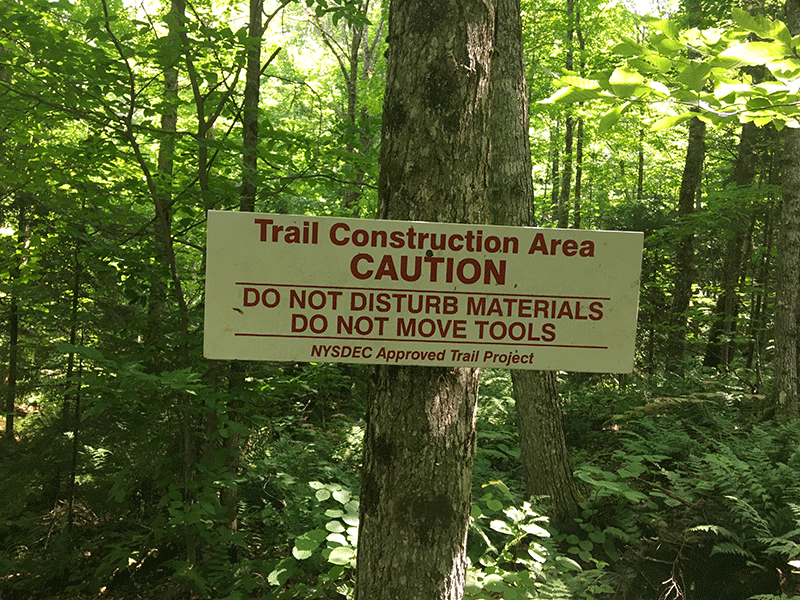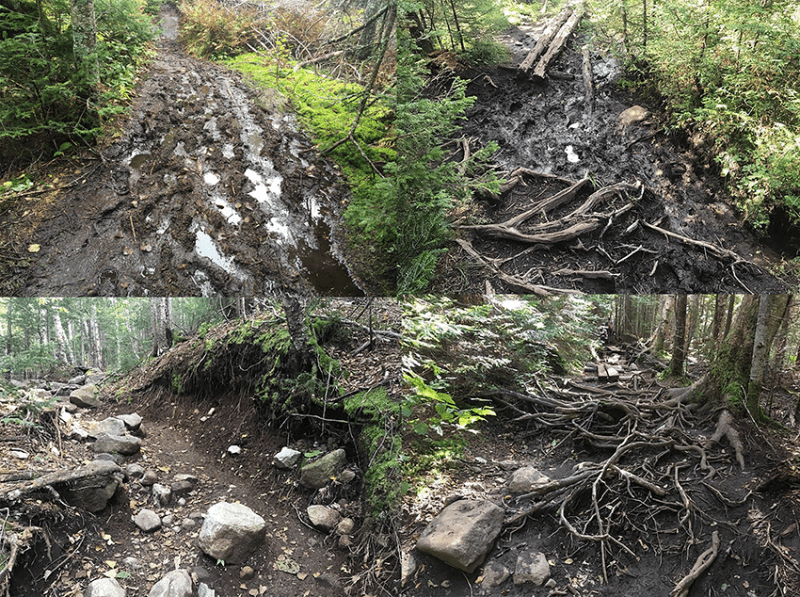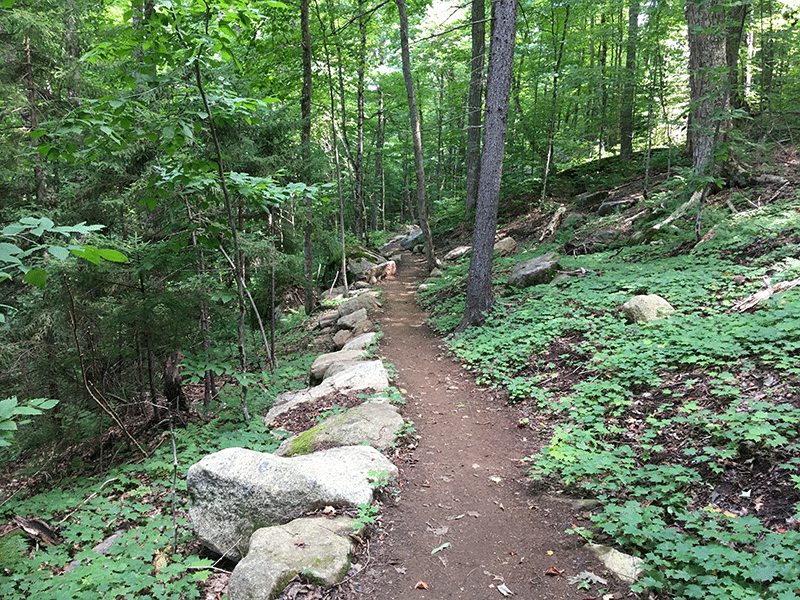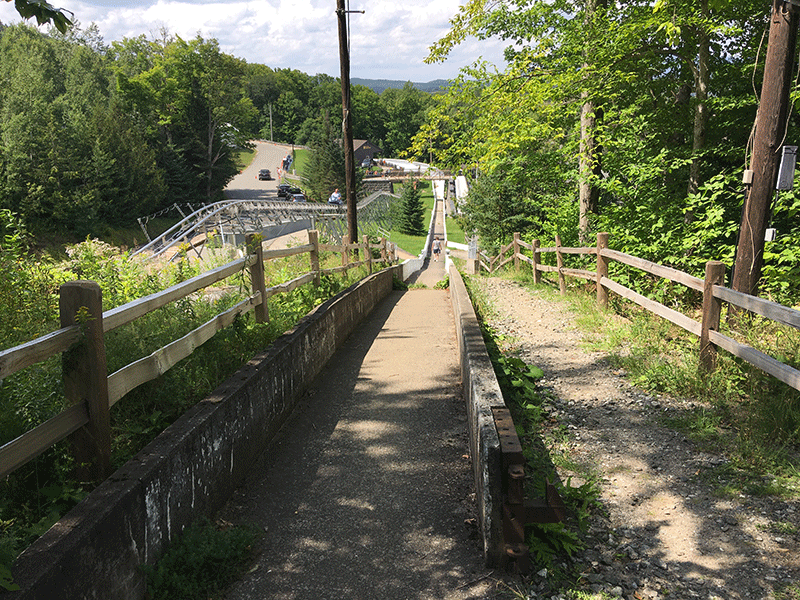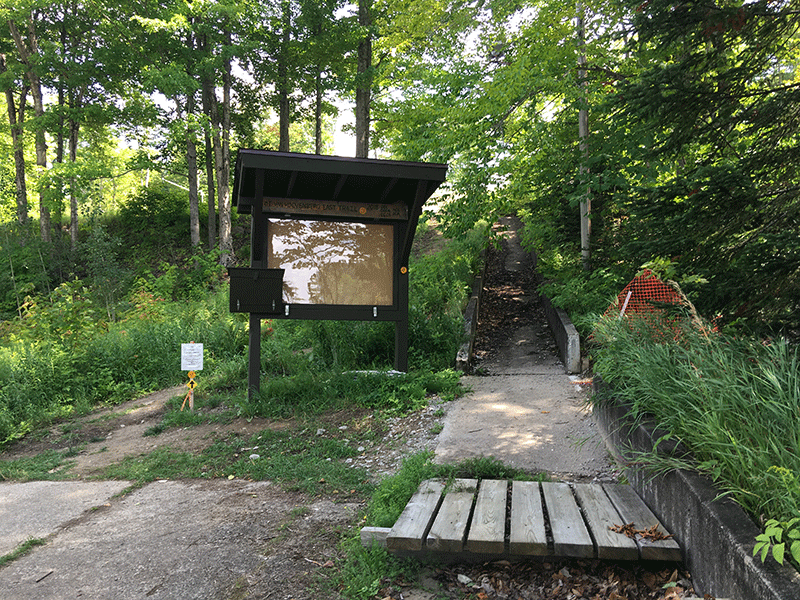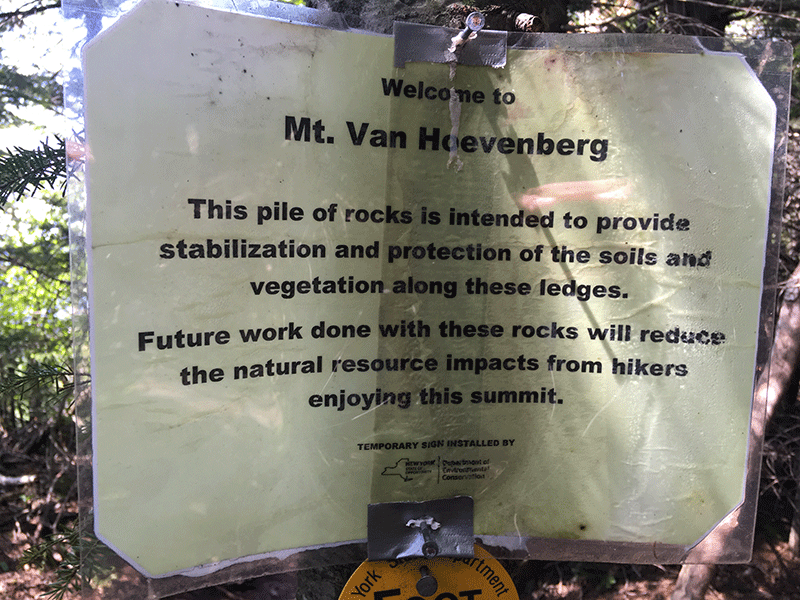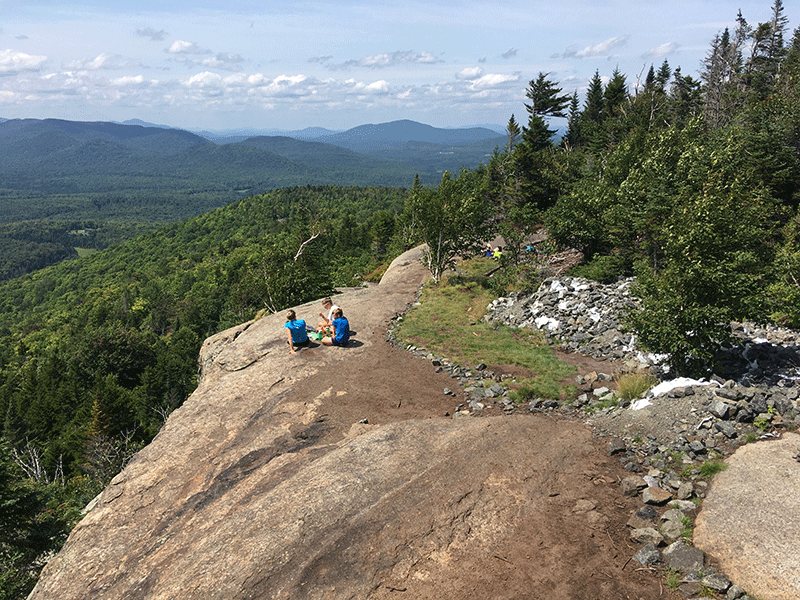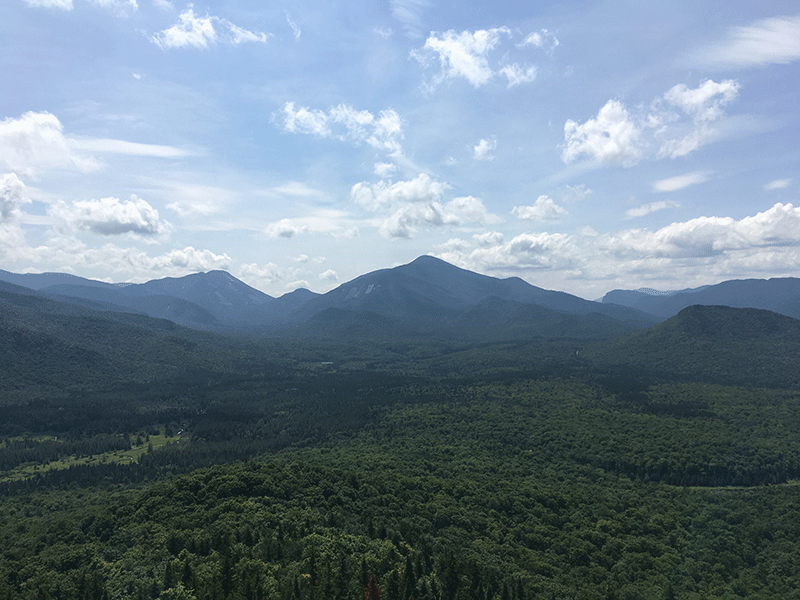This new trail is a model for the High Peaks Wilderness Area and the Forest Preserve
In the late summer of 2019, Protect the Adirondacks visited the trail construction project on Mount Van Hoevenberg. Click here to read our report on the initial work.
The new sustainable hiking trail under construction to the summit of Mount Van Hoevenberg is expected to be completed in the early fall. This project has been a priority of the Department of Environmental Conservation (DEC). This project started in 2018 and marked a completely different approach to hiking trail building in the Forest Preserve and the High Peaks Wilderness. For the first time, the DEC committed to a multi-year effort to showcase new sustainable trail design and trail building techniques for the Forest Preserve. In many ways, this trail marks a new beginning for the state’s approach to hiking trail building in the Adirondack Park.
The new Mount Van Hoevenberg (MVH) trail begins at the Mount Van Hoevenberg Winter Olympic Sports Complex,managed by the Olympic Regional Development Authority (ORDA), between Lake Placid and Keene. The new MVH trail design was an attempt to build a hiking trail that would be a much easier trail to hike than the typical trail in the High Peaks Wilderness, or most other places in the Forest Preserve, that runs straight up the mountainside. These steep “fall line” trails often become water channels that change the hydrology of a mountainside and are prone to erosion as they become a muddy streambed of rocks and tree roots, where soils often wash away to bedrock.
The new sustainable hiking trails are narrow contour trails that are cut into the mountainside on a course based on a slow, steady gradient. While elevation is steadily gained, the trail has a smooth tread surface of compacted mineral soils, devoid of boulders and roots. There is an occasional single rock step in sections that changes the grade. Contour trails are designed to withstand heavy recreational use and to prevent erosion. They are built to facilitate single-file hiking on a narrow trail built with natural materials that blend in with the surrounding forest and mountains. These contour trails are drier and not as steep as standard hiking trails in the High Peaks. As a result these trails will likely be more accessible to the general public.
The route is a vital part of the design of a sustainable contour trail. The trail is routed on a steady gradient to gradually gain elevation at a 10% grade. This small grade effectively manages stormwater by shedding water all along its surface to prevent erosion and trail damage. A grade over 15% significantly increases the risk of erosion. The top sections of the MVH trail, which rises steeply, feature extensive staircases either framed with large rocks and filled with mineral soils on top of a crushed rock base, or large stone slabs.
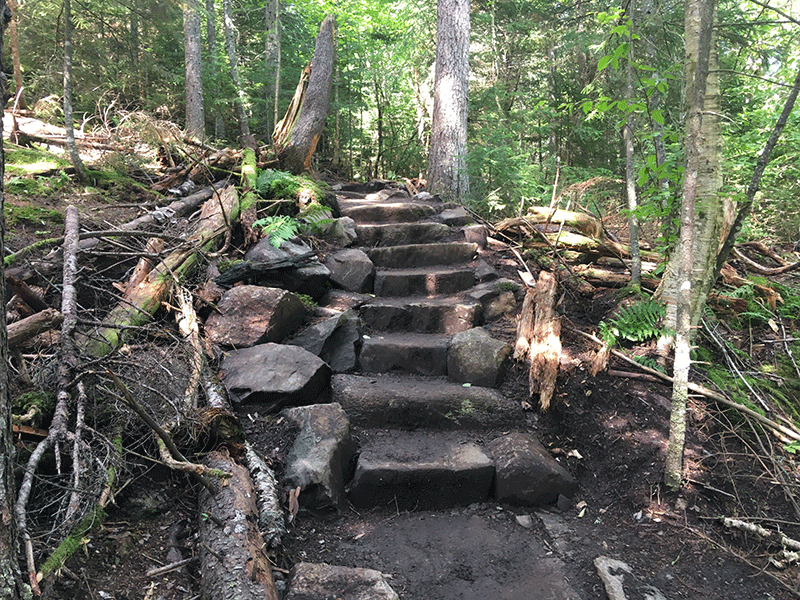
Stone staircase built as part of the new trail. These are more frequent at the higher elevation part of the new trail.
Contour trails are dug into a hillside with hand tools. The trail is designed to have a 2-foot-wide trail tread area for hikers. This is a slow, methodical process. A long trench is dug out on a hillside or through the forest floor to anchor the trail and is then lined with a base of crushed stone 6-8 inches deep. This stone is “harvested” as large boulders from the trail corridor or surrounding forest are dug up and smashed into baseball-size rocks. The downslope side of the trail is generally lined with large rocks that are buried along the edge to stabilize the trail. Mineral soils at a depth of 4-6 inches are placed over the top of the base of crushed stone. By design water flows down the hillside and through the rock base of the trail, and never forms into a long channel. This means that these trails are projected to endure Adirondack weather conditions much better than existing trails and require much less long-term maintenance beyond clearing blowdown and clearing debris.
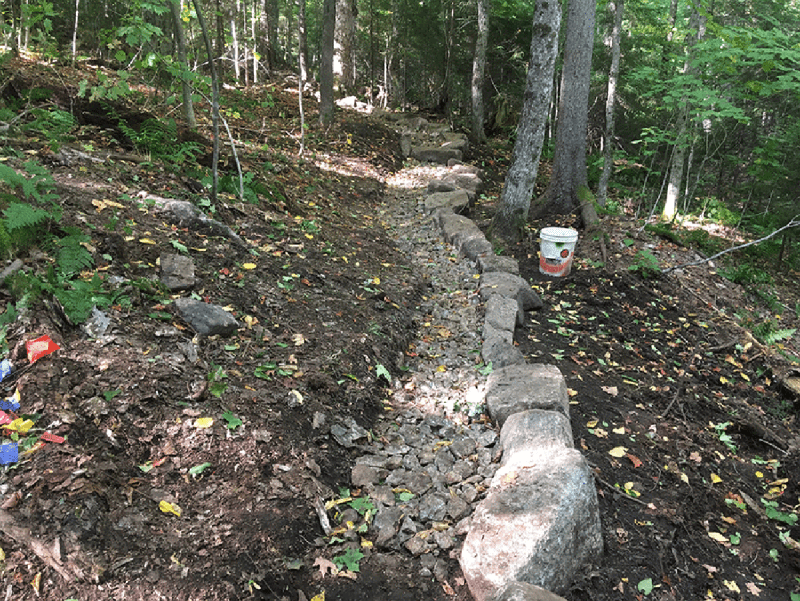
A section of the new sustainable hiking trail up Mount Van Hoevenberg where the base of the trail has been lined with rocks.
Many of the major hiking trails in the High Peaks Wilderness were built in the decades after the American Civil War. Due to their poor design, or lack of design, these trails are expensive to maintain and despite heroic efforts over the years to “harden” these trails they remain in poor condition. There are many band-aid efforts to salvage failed trails, such as a long, wooden staircases bolted into the Mount Colden or Ore Bed trails. The new sustainable MVH trail is designed primarily using rocks, which will not wear away like wooden bog bridges or staircases or log walkways. These trails are designed to uphold and accentuate the wilderness character and the wilderness atmosphere of the area. In many ways the current dismal state of hiking trails in the High Peaks has undermined the wilderness values of the area.
For a number of years, Protect the Adirondacks has campaigned for greater resources to be invested by the State of New York in rebuilding the trails in the High Peaks Wilderness and the Forest Preserve and we will continue to press for even greater investments in the years to come. The Cuomo Administration refused to get serious about rebuilding trails in the Forest Preserve. We hope the Hochul Administration will be better. The new Mount Van Hoevenberg and Cascade Mountain trails show what the future could be.
ORDA recently completed a $5.1 million amusement mountain-coaster ride at the Mount Van Hoevenberg Winter Sports Complex. So far this year, around 9,000 people have ridden the mountain-coaster. Less than two miles away at Cascade Mountain about twice that many people have hiked up the mountain this year, yet the Forest Preserve has never seen a $5 million investment in trail building. At current rates of the DEC leadership’s anemic spending on the Forest Preserve it will take 150 years to rebuild the 300 miles of hiking trails in the High Peaks, which means we’ll never catch up. And then there’s the 1,500 miles of hiking trails across the rest of the Forest Preserve in the Adirondacks.
In 2019, researchers at the Huntington Wildlife Forest at SUNY ESF were contracted to undertake baseline ecological studies of the forest, flora and wildlife along the new MVH trail. This is one of the rare times that Forest Preserve planners will have baseline data prior to recreational use to evaluate changes over time to the natural resources of a trail corridor.
The new trail up Cascade Mountain is set for major work to resume in 2022 and trail work is expected to go faster than 4-year effort to build the MVH trail. The MVH trail was slowed by people regularly hiking straight through the work zone throughout its work, and was delayed by the state working out COVID protocols for its trail crew and contract crews in 2020. DEC also had to train its crews, and its contract trail building crews, in the new sustainable trail building techniques, which took time. As DEC has retained trail crew members from previous years, and as contract crews returned, the crews have dramatically increased the quality and quantity of their work. Tahawus Trails, a private trail builder, and the Student Conservation Association, were contracted for work on the MVH trail.
The total amount of tree cutting on the new MVH trail may never be known. The trail was cut out at a point in 2018 when the state did not count trees under 3” DBH. The state has kept a tally of trees over 3” DBH, which changed as new work plans were created and the trail was re-routed. There are two long stretches of trail that were cut out and abandoned because the alignment was incorrect. The DEC has not released information on total tree counts.
The new MVH trail also reveals a major reform that’s needed at the DEC. The state needs to get serious about professional trail building and recognize that people who work on a trail like the MVH trail are skilled professionals and not simply laborers hired for minimum wage. The state needs to make Forest Preserve trail crews seasonal professionals who are part of the state civil service so that experienced people come back year after year. Volunteer trail crews and crews of student interns certainly help with trail maintenance and trail building, but their work does not compare with that of trained professionals. In recent years, the DEC has continued to whittle away at civil service titles of staff who work in the field, taking advantage of poorly paid contract staff to supervise management on hundreds of thousands of acres of Forest Preserve lands.
The trail to Mount Van Hoevenberg and Cascade and Porter Mountains starts in a back alley behind a service building up the hill from the new $20 million main lodge at the ORDA Winter Sports Complex. Hikers walk around the back of the new main lodge and up a sandy path of loose stone next to a section of the old concrete bobsled track. The approach to the trailhead needs work.
The trailhead is jarring, very different from all other Adirondack trailheads, where one parks their vehicle and within a few minutes they are deep in the forest, and with every step gets further away from the highway, further away from the concrete world, and deeper into the Forest Preserve. The new trailhead for Mount Van Hoevenberg and Cascade and Porter Mountains demands that hikers navigate their way through the new Winter Olympic Sports Complex, which was been rebuilt top to bottom in order to host the World University Games in 2023. While this facility has unlimited parking, vast public restrooms, and a snack bar and shop with hiking supplies, there is also music blaring from the mountain-coaster loading area and hikers are treated to the drone of a continuous instructional recording for mountain-coaster riders over the first several hundred yards of trail during summer months. On the way to the hiking trailhead, however, one can stop and hop onto the medal ceremony podiums and pose for a picture, so that’s a perk unavailable at any other trailhead.
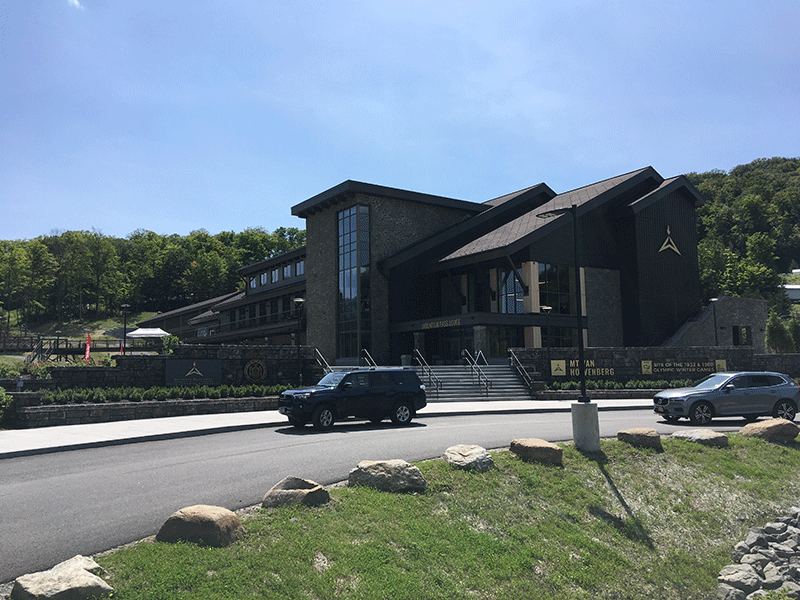
The new lodge at the Mount Van Hoevenberg Winter Sports Complex managed by the Olympic Regional Development Authority.
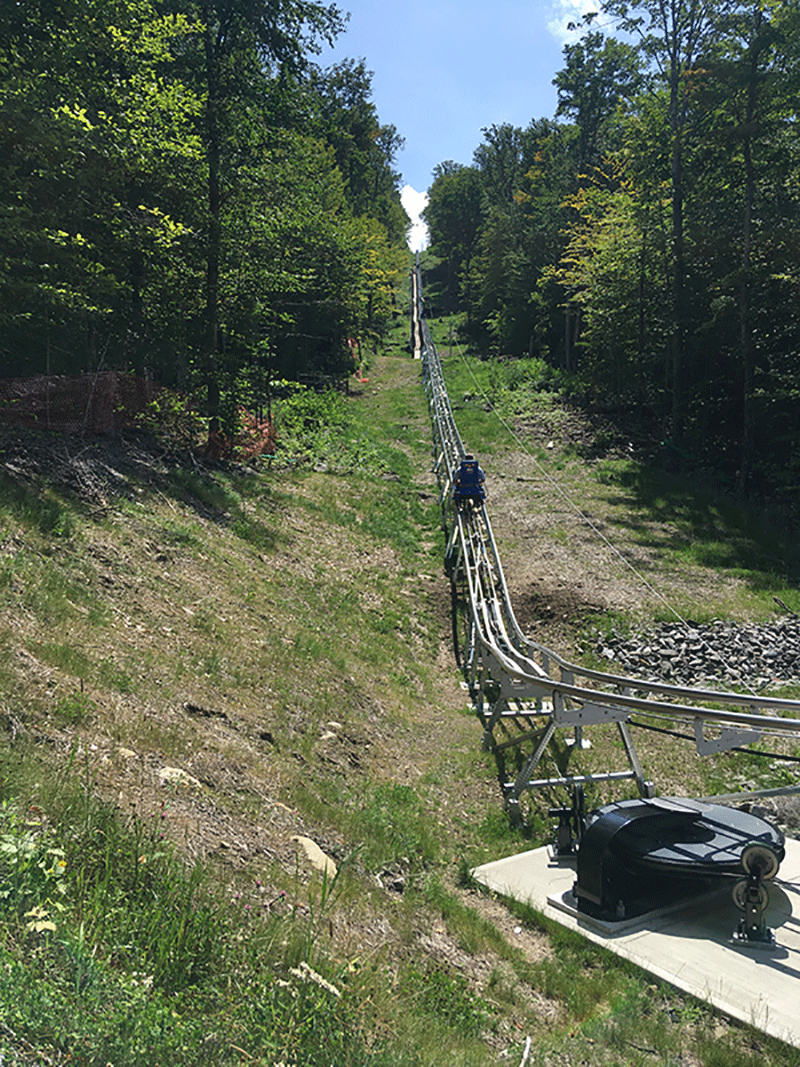
A view of the lower section of the new “mountain-coaster” that runs beside the beginning of the new hiking trail up Mount Van Hoevenberg.
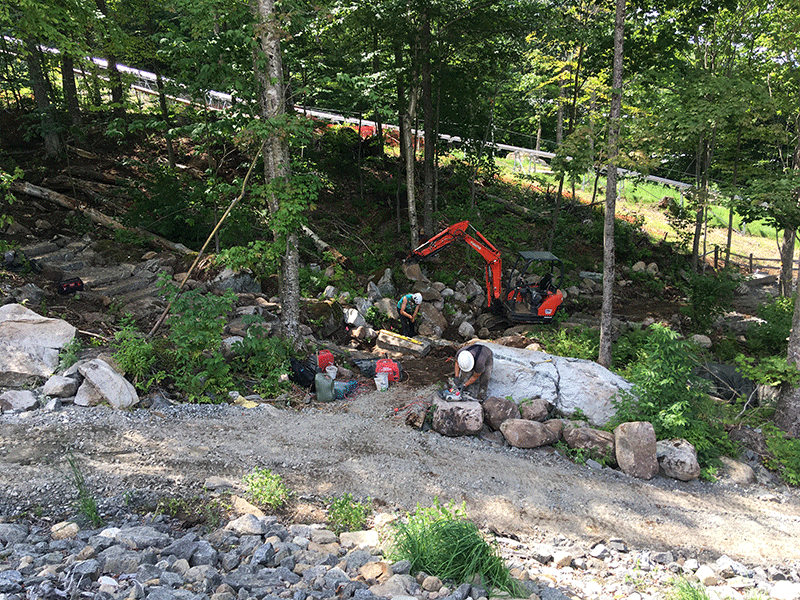
Heavy machinery is use to construct the large rock staircase at the base of the new Mount Van Hoevenberg trail on Town of North Elba lands.
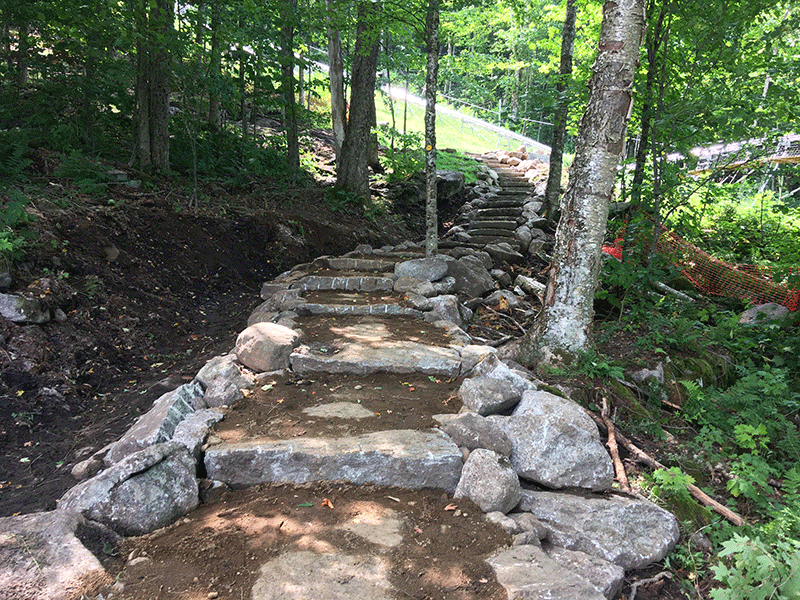
The new rock staircase at the base of the new Mount Van Hoevenberg trail under construction on Town of North Elba lands.
The first few hundred yards of the new MVH trail is in the shadow of the new mountain-coaster. The initial quarter mile or so of the hiking trail is on Town of North Elba lands, also managed by ORDA, which means that trail building work was undertaken with a backhoe and no one worried about tree cutting limitations. This part of the trail is steep and begins with a massive stone staircase that leads to a hiking trail that connects to the High Peaks Wilderness Area.
After about a mile or so, the new trail up Mount Van Hoevenberg forks. This is where the new trail up Cascade and Porter Mountains will begin. This trail has been marked and some work started but trail work will resume in earnest in 2022. The new Cascade Mountain Trail will start at the same trailhead as the Mount Van Hoevenberg Trail at the Olympic Winter Sports Complex and will intersect with the existing trail between Cascade and Porter Mountains. The new trail will utilize the existing trail at this point, which will be rebuilt, to reach the summits of both mountains. This will cause far less damage than cutting a new trail through the Krummholz forest of small diameter old growth trees, though it will require extensive rock work to build many stone staircases. The higher a hiking trail gets in elevation, the fewer options there are for trail builders as soils are thin and then disappear altogether.
The summit of Mount Van Hoevenberg is a mess. DEC flew in dozens of bags of baseball-sized shot-rock which are piled in places on the summit. The DEC has undertaken various summit stabilization efforts, but the shot-rock looks out of place and unnatural on the summit and the shredded plastic bags of rocks are numerous.
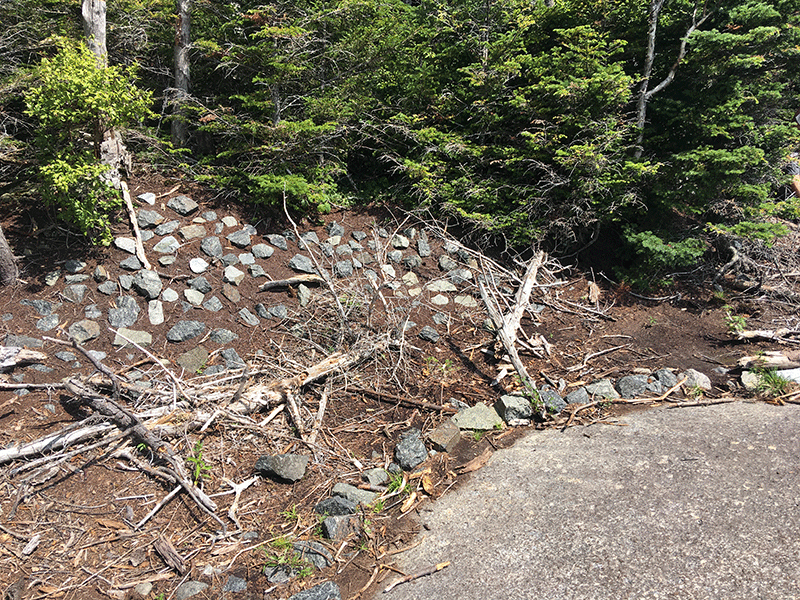
Summit restoration work on Mount Van Hoevenberg using shot rock transported to the summit via a helicopter.
Despite the issues at the trailhead and the mess on the summit, the new trail up Mount Van Hoevenberg is impressive, one of single best things the DEC has accomplished in Forest Preserve management in years. While the Basil Seggos years at the DEC will be remembered for violating Article 14 and widely expanding motor vehicle access across the Forest Preserve, it will also be known for taking a chance on building the first major sustainable hiking trail, designed and built with Wilderness management principles, designed to blend in with its Wilderness surroundings, and to handle the heavy recreational use seen in the High Peaks.

